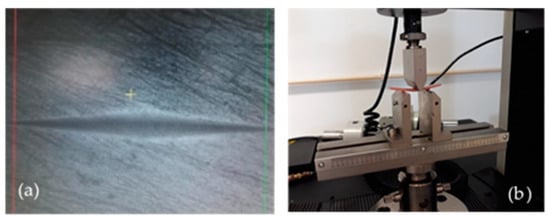Abstract
Polymethylmethacrylate is the material of choice for prosthetic bases. Depending on the type of polymerization, acrylic resins may present some mechanical weaknesses that may lead to the failure of a prosthesis. The microhardness and flexural strength of a dental material determine its applicability. The objective of the present investigation was to evaluate the in vitro Knoop microhardness and flexural strength of a thermopolymerizable (Probase Hot) and an autopolymerizable (Probase Cold) resin, according to ISO 20759-1: 2013.
1. Introduction
Acrylic resins based on polymethylmethacrylate (PMMA) are obtained by the polymerization of the methylmethacrylate monomer and can be divided into two large groups: “heat-cured” or thermopolymerizable, when polymerization starts with heat, and “cold-cured” or autopolymerizable, when they are chemically activated [].
Despite some desirable characteristics, PMMA also has some mechanical weaknesses that can lead to fracture, making its ability to resist to fracture a very important parameter that must be be evaluated, specifically, through microhardness and three-point bending tests [,].
2. Materials and Methods
Respecting the manufacturer’s standards and in accordance with ISO 20759-1: 2013 [], a total of 10 rectangular specimens of PMMA-based resin were made, i.e., 5 of Probase Hot (PBH) resin and 5 of Probase Cold (PBC) resin, with dimensions of 64 × 10 × 3.3 mm. The specimens were polished with 500 and 100 grain silicon carbide sandpaper and then cooled to room temperature. The specimens were stored in water and incubated at the temperature of 37 ± 1 °C for 48 ± 2 h. The microhardness of each sample was determined using the Knoop test through a Knoop indenter connected to a microhardness machine. In each sample, five indentations were made that the program converted to Knoop microhardness values expressed in kg/mm2, obtaining the average values. For flexural strength evaluation, the specimens were submitted to the three-point bending test, performed on a universal servo-hydraulic testing machine. Each specimen was tested, applying a distance between the supports of 50 mm and a load to the center of each specimen, using a cross speed of 5 mm/min. Then, the values of the individual measurements (width and thickness) for each specimen were entered into the machine software. Finally, the load was applied, following guidelines from other similar studies until the specimen was fractured, and the fracture load value was recorded in Newton (N). The results obtained were analyzed and compared with a t-test, using SPSS software.
3. Results and Discussion
The results obtained through the microhardness test and the three-point bending test (Figure 1) showed significant differences (p < 0.001) for the resins under study (Figure 2).

Figure 1.
Tests: (a) Knoop indentation visualized with an optical microscope; (b) three-point bending test.

Figure 2.
Mechanical characteristics of Probase Hot (orange) and Probase Cold (blue) acrylic resins measured by (a) the Knoop microhardness test and (b) the three-point bending test.
Thus, within the limitations of this study, the PBH resin presented higher microhardness and flexural strength values than the PBC resin. Scientific evidence demonstrates that autopolymerizable acrylic resins have a lower degree of polymerization. Incomplete polymerization in highly porous structures reduces the physical and mechanical quality of resins []. Therefore, this may explain the lower microhardness and flexural strength of PBC.
Institutional Review Board Statement
Not applicable.
Informed Consent Statement
Not applicable.
Data Availability Statement
The data required to reproduce these findings cannot be shared at this time as the data also forms part of an ongoing study.
Conflicts of Interest
The authors declare no conflict of interest.
References
- Cervino, G.; Cicciù, M.; Herford, A.S.; Germanà, A.; Fiorillo, L. Biological and Chemo-Physical Features of Denture Resin. Materials 2020, 13, 3350. [Google Scholar] [CrossRef] [PubMed]
- Ozkir, S.E.; Yilmaz, B.; Unal, S.M.; Culhaoglu, A.; Kurkcuoglu. Effect of heat polymerization conditions and microwave on the flexural strength of polymethylmethacrylate. Eur. J. Dent. 2018, 12, 116–119. [Google Scholar] [CrossRef] [PubMed]
- Camacho, D.; Svidzinki, T.; Furlaneto, M.; Lopes, M.; Corrêa, G. Acrylic resins for dental use based polymethylmethacrylate. Braz. J. Surg. Clin. Res. 2014, 6, 63–72. [Google Scholar] [CrossRef]
- ISO 20795-1. Dentistry—Base Polymers—Part 1: Denture Base Polymers; International Organization for Standardization: Geneva, Switzerland, 2013. [Google Scholar]
- Kostic, M.; Petrovic, M.; Krunic, N.; Igic, M.; Janosevic, P. Comparative analysis of water sorption by different acrylic materials. Acta Med. Median. 2014, 53, 5–9. [Google Scholar] [CrossRef]
Publisher’s Note: MDPI stays neutral with regard to jurisdictional claims in published maps and institutional affiliations. |
© 2021 by the authors. Licensee MDPI, Basel, Switzerland. This article is an open access article distributed under the terms and conditions of the Creative Commons Attribution (CC BY) license (https://creativecommons.org/licenses/by/4.0/).